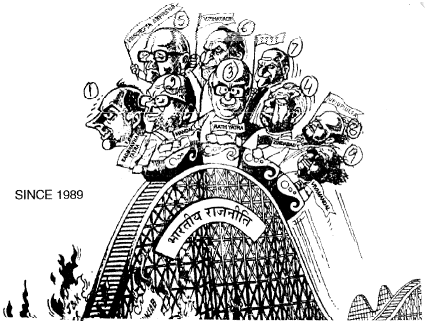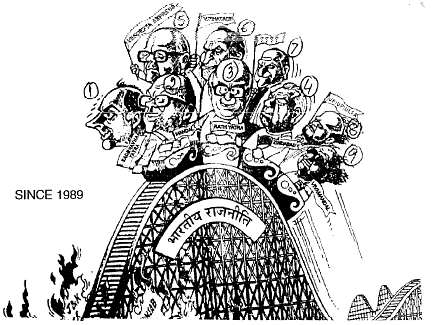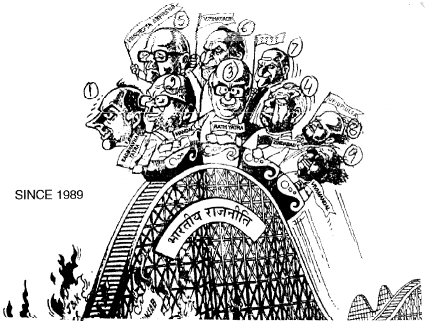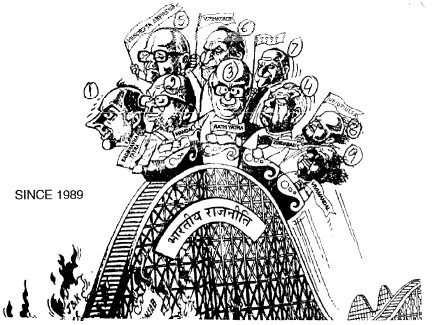Test: Recent Developments in Indian Politics- Case Based Type Questions - Humanities/Arts MCQ
16 Questions MCQ Test Political Science Class 12 - Test: Recent Developments in Indian Politics- Case Based Type Questions
Study the cartoon given below and answer the following questions:

Q. Which was the most controversial issue of the period related to leader no. 2 as Prime Minister of India?

Study the cartoon given below and answer the following questions:

Q. In 1989 elections, how many seats did Congress win?

Study the cartoon given below and answer the following questions:

Q.Identify the leader numbered 3 in the cartoon.

Study the cartoon given below and answer the following questions:

Q. Who is leader numbered 1 here? What was the result of the 1989 elections led by him?
Read the passage given below carefully and answer the questions that follows:
The nineties also saw the emergence of powerful parties and movements that represented the Dalit and backward castes (Other Backward Classes or OBCs). Many of these parties represented powerful regional assertion as well. These parties played an important role in the United Front government that came to power in 1996. The United Front was similar to the National Front of 1989 for it included Janata Dal and several regional parties. This time the BJP did not support the government. The United Front government was supported by the Congress. This shows how unstable the political equations were. In 1989, both the Left and the BJP supported the National Front Government because they wanted to keep the Congress out of power. In 1996, the Left continued to support the non-Congress government but this time the Congress, supported it, as both the Congress and the Left wanted to keep the BJP out of power.
Q. When was the United Front Government formed?
Read the passage given below carefully and answer the questions that follows:
The nineties also saw the emergence of powerful parties and movements that represented the Dalit and backward castes (Other Backward Classes or OBCs). Many of these parties represented powerful regional assertion as well. These parties played an important role in the United Front government that came to power in 1996. The United Front was similar to the National Front of 1989 for it included Janata Dal and several regional parties. This time the BJP did not support the government. The United Front government was supported by the Congress. This shows how unstable the political equations were. In 1989, both the Left and the BJP supported the National Front Government because they wanted to keep the Congress out of power. In 1996, the Left continued to support the non-Congress government but this time the Congress, supported it, as both the Congress and the Left wanted to keep the BJP out of power.
Q. The Left and Congress continued to support United Front government:
Read the passage given below carefully and answer the questions that follows:
The nineties also saw the emergence of powerful parties and movements that represented the Dalit and backward castes (Other Backward Classes or OBCs). Many of these parties represented powerful regional assertion as well. These parties played an important role in the United Front government that came to power in 1996. The United Front was similar to the National Front of 1989 for it included Janata Dal and several regional parties. This time the BJP did not support the government. The United Front government was supported by the Congress. This shows how unstable the political equations were. In 1989, both the Left and the BJP supported the National Front Government because they wanted to keep the Congress out of power. In 1996, the Left continued to support the non-Congress government but this time the Congress, supported it, as both the Congress and the Left wanted to keep the BJP out of power.
Q. What is the full form of OBC?
Read the passage given below carefully and answer the questions that follows:
The nineties also saw the emergence of powerful parties and movements that represented the Dalit and backward castes (Other Backward Classes or OBCs). Many of these parties represented powerful regional assertion as well. These parties played an important role in the United Front government that came to power in 1996. The United Front was similar to the National Front of 1989 for it included Janata Dal and several regional parties. This time the BJP did not support the government. The United Front government was supported by the Congress. This shows how unstable the political equations were. In 1989, both the Left and the BJP supported the National Front Government because they wanted to keep the Congress out of power. In 1996, the Left continued to support the non-Congress government but this time the Congress, supported it, as both the Congress and the Left wanted to keep the BJP out of power.
Q. Who supported the United Front Government?
Read the following paragraph carefully and answer the questions that follows:
Thus, with the elections of 1989, a long phase of coalition politics began in India. Since then, there have been eleven governments at the Centre, all of which have either been coalition governments or minority governments supported by other parties, which did not join the government. In this new phase, any government could be formed only with the participation or support of many regional parties. This applied to the National Front in 1989, the United Front in 1996 and 1997, the NDA in 1997, the BJP- led coalition in 1998, the NDA in 1999, and the UPA in 2004 and 2009. However, this trend changed in 2014. Let us connect this development with what we have learnt so far. The era of coalition governments may be seen as a long-term trend resulting from relatively silent changes that were taking place over the last few decades.
In the 1980s, the Janata Dal brought together a similar combination of political groups with strong support among the OBCs. The decision of the National Front government to implement the recommendations of the Mandal Commission further helped in shaping the politics of ‘Other Backward Classes’. The intense national debate for and against reservation in jobs made people from the OBC communities more aware of this identity.
Q. In which years, mentioned above, did NDA have coalition governments?
Read the following paragraph carefully and answer the questions that follows:
Thus, with the elections of 1989, a long phase of coalition politics began in India. Since then, there have been eleven governments at the Centre, all of which have either been coalition governments or minority governments supported by other parties, which did not join the government. In this new phase, any government could be formed only with the participation or support of many regional parties. This applied to the National Front in 1989, the United Front in 1996 and 1997, the NDA in 1997, the BJP- led coalition in 1998, the NDA in 1999, and the UPA in 2004 and 2009. However, this trend changed in 2014. Let us connect this development with what we have learnt so far. The era of coalition governments may be seen as a long-term trend resulting from relatively silent changes that were taking place over the last few decades.
In the 1980s, the Janata Dal brought together a similar combination of political groups with strong support among the OBCs. The decision of the National Front government to implement the recommendations of the Mandal Commission further helped in shaping the politics of ‘Other Backward Classes’. The intense national debate for and against reservation in jobs made people from the OBC communities more aware of this identity.
Q. Which government took the decision to implement the recommendations of the Mandal Commission?
Read the following paragraph carefully and answer the questions that follows:
Thus, with the elections of 1989, a long phase of coalition politics began in India. Since then, there have been eleven governments at the Centre, all of which have either been coalition governments or minority governments supported by other parties, which did not join the government. In this new phase, any government could be formed only with the participation or support of many regional parties. This applied to the National Front in 1989, the United Front in 1996 and 1997, the NDA in 1997, the BJP- led coalition in 1998, the NDA in 1999, and the UPA in 2004 and 2009. However, this trend changed in 2014. Let us connect this development with what we have learnt so far. The era of coalition governments may be seen as a long-term trend resulting from relatively silent changes that were taking place over the last few decades.
In the 1980s, the Janata Dal brought together a similar combination of political groups with strong support among the OBCs. The decision of the National Front government to implement the recommendations of the Mandal Commission further helped in shaping the politics of ‘Other Backward Classes’. The intense national debate for and against reservation in jobs made people from the OBC communities more aware of this identity.
Q. Why is a coalition government formed?
Read the following paragraph carefully and answer the questions that follows:
Thus, with the elections of 1989, a long phase of coalition politics began in India. Since then, there have been eleven governments at the Centre, all of which have either been coalition governments or minority governments supported by other parties, which did not join the government. In this new phase, any government could be formed only with the participation or support of many regional parties. This applied to the National Front in 1989, the United Front in 1996 and 1997, the NDA in 1997, the BJP- led coalition in 1998, the NDA in 1999, and the UPA in 2004 and 2009. However, this trend changed in 2014. Let us connect this development with what we have learnt so far. The era of coalition governments may be seen as a long-term trend resulting from relatively silent changes that were taking place over the last few decades.
In the 1980s, the Janata Dal brought together a similar combination of political groups with strong support among the OBCs. The decision of the National Front government to implement the recommendations of the Mandal Commission further helped in shaping the politics of ‘Other Backward Classes’. The intense national debate for and against reservation in jobs made people from the OBC communities more aware of this identity.
Q. In which years UPA governments were formed?
Read the following excerpt carefully and answer the questions that follows:
Federalism is an instrument of power sharing between independent authorities’ viz. Union and State. Coalition government is also a means of power sharing. Logically both federalism and coalition government should be complimentary to each other. As the object of sharing of power is common in both, a student of politics or law may gather the impression that coalition government is always supportive of federal form of government or constitution and sometime also gives more opportunity for expression of ideas and democratic rights to small and regional parties. In this way it seems that coalition government promotes democracy and representative administration. But there are some grey areas also of the coalition politics like sometimes the coalition which are formed after declaration of election which give rise to ‘horse trading’ for the purpose of proving majority on the floor of house of representatives.
Vajpayee led National Democratic Alliance from 1999 to 2004. While some say that coalition governments generate more inclusive policies, others believe that coalitions impose constraints on policy making.
Q. What is common in both (Federalism and Coalition Government)?
Read the following excerpt carefully and answer the questions that follows:
Federalism is an instrument of power sharing between independent authorities’ viz. Union and State. Coalition government is also a means of power sharing. Logically both federalism and coalition government should be complimentary to each other. As the object of sharing of power is common in both, a student of politics or law may gather the impression that coalition government is always supportive of federal form of government or constitution and sometime also gives more opportunity for expression of ideas and democratic rights to small and regional parties. In this way it seems that coalition government promotes democracy and representative administration. But there are some grey areas also of the coalition politics like sometimes the coalition which are formed after declaration of election which give rise to ‘horse trading’ for the purpose of proving majority on the floor of house of representatives.
Vajpayee led National Democratic Alliance from 1999 to 2004. While some say that coalition governments generate more inclusive policies, others believe that coalitions impose constraints on policy making.
Q. Atal Bihari Vajpayee served as the PM of India from:
(a) 2000 to 2005
(b) 2003 to 2014
(c) 1999 to 2004
(d) None of the above
Read the following excerpt carefully and answer the questions that follows:
Federalism is an instrument of power sharing between independent authorities’ viz. Union and State. Coalition government is also a means of power sharing. Logically both federalism and coalition government should be complimentary to each other. As the object of sharing of power is common in both, a student of politics or law may gather the impression that coalition government is always supportive of federal form of government or constitution and sometime also gives more opportunity for expression of ideas and democratic rights to small and regional parties. In this way it seems that coalition government promotes democracy and representative administration. But there are some grey areas also of the coalition politics like sometimes the coalition which are formed after declaration of election which give rise to ‘horse trading’ for the purpose of proving majority on the floor of house of representatives.
Vajpayee led National Democratic Alliance from 1999 to 2004. While some say that coalition governments generate more inclusive policies, others believe that coalitions impose constraints on policy making.
Q. What, according to the above paragraph, is an instrument of power sharing?
Read the following excerpt carefully and answer the questions that follows:
Federalism is an instrument of power sharing between independent authorities’ viz. Union and State. Coalition government is also a means of power sharing. Logically both federalism and coalition government should be complimentary to each other. As the object of sharing of power is common in both, a student of politics or law may gather the impression that coalition government is always supportive of federal form of government or constitution and sometime also gives more opportunity for expression of ideas and democratic rights to small and regional parties. In this way it seems that coalition government promotes democracy and representative administration. But there are some grey areas also of the coalition politics like sometimes the coalition which are formed after declaration of election which give rise to ‘horse trading’ for the purpose of proving majority on the floor of house of representatives.
Vajpayee led National Democratic Alliance from 1999 to 2004. While some say that coalition governments generate more inclusive policies, others believe that coalitions impose constraints on policy making.
Q. What is one of the “grey areas” of coalition politics?
|
34 videos|246 docs|52 tests
|


















